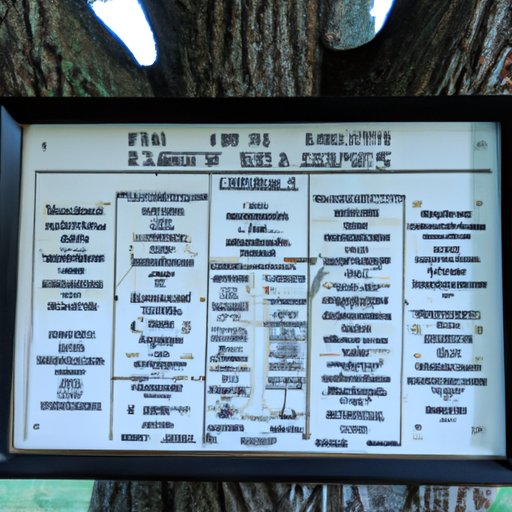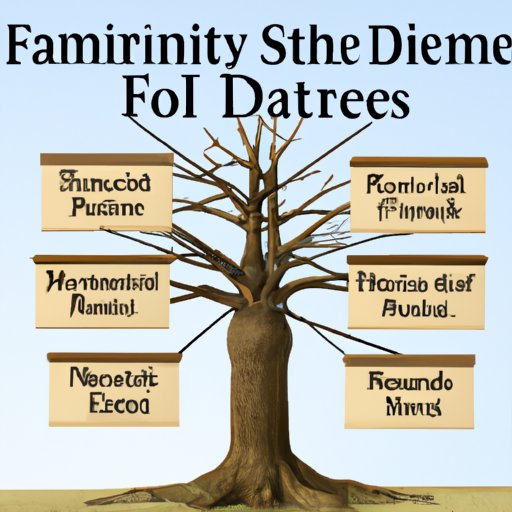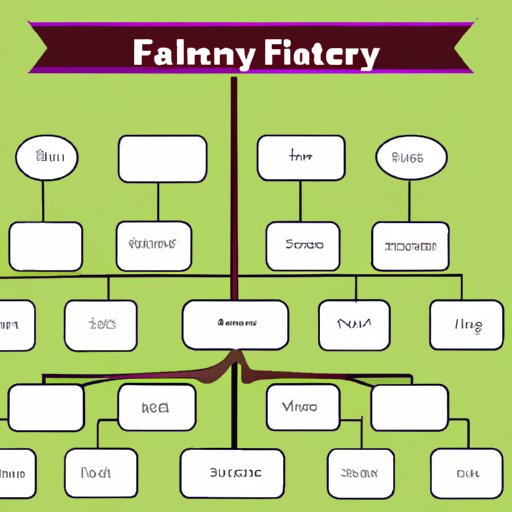Introduction
A family tree is a visual representation of an individual’s ancestors and their descendants. It is used to trace one’s lineage and explore family history. Creating and maintaining an accurate family tree is an important tool for understanding the past and connecting with distant relatives.
Explaining the Basics of a Family Tree
The components of a family tree include individuals, relationships, and dates. Individuals are represented by boxes or circles, while the relationship between them is indicated by a line or arrow. Each individual’s name, birth date, marriage date, and death date are listed on the chart.
Family trees can be quite complex, depending on the number of generations that are included. Each generation is indicated by a different level of the tree, with the earliest generation at the top and the most recent generation at the bottom. The relationships between individuals can vary from siblings to cousins to grandchildren.
Outlining the Steps to Creating a Family Tree
Constructing a family tree begins with identifying the most important family members. These can include grandparents, parents, siblings, aunts, uncles, and cousins. Once these individuals have been identified, it is important to gather as much information about each person as possible. This can include birth and death dates, marriage and divorce dates, and other important events in their lives.
Once all of the information has been gathered, it should be documented on a family tree chart. This includes writing down each individual’s name and listing their relationship to other family members. Dates of birth, marriage, and death should also be included.
Examining How Technology Can Help with Constructing a Family Tree
Technology has made creating a family tree easier than ever before. There are numerous online resources available to help with this process. For example, websites like Ancestry.com allow users to search for records and create a family tree with just a few clicks.
Genealogy software programs can also be used to construct a family tree. These programs allow users to collect, organize, and store data about their family history. They also provide helpful tools such as automated searches, timeline views, and charts.

Showcasing Historical Examples of Family Trees
Throughout history, there have been many famous family trees. One of the most famous is the Tudor Dynasty family tree. This family tree was created in the 16th century and includes the royal families of England, Scotland, Ireland, and Wales. Another prominent family tree is the Habsburg Dynasty family tree, which includes the royal families of Austria, Spain, Hungary, and Bohemia.
These family trees are significant because they provide insight into the history of powerful dynasties and the connections between them. They also demonstrate the importance of having an accurate family tree, as errors in the records could have had serious consequences.

Discussing How to Interpret and Use Information on a Family Tree
A family tree can contain a wealth of information about an individual’s family history. This can include names, dates, places, occupations, and other important details. This information can be used to research a family’s past and uncover new information about ancestors. It can also be used to connect with distant relatives and learn more about their lives.

Demonstrating the Importance of Maintaining an Accurate Family Tree
Having an accurate family tree is essential for maintaining an accurate record of family history. It is important to keep the family tree up-to-date by adding new information as it becomes available. This can include births, deaths, marriages, divorces, and other major life events. Keeping a family tree up-to-date will ensure that future generations have an accurate record of their family history.
Conclusion
Creating a family tree is an important way to explore your family’s history. It involves identifying important family members, gathering information about each individual, and documenting it on a family tree chart. Technology can be used to help with this process, and historical examples of family trees showcase the importance of having an accurate family tree. Finally, having an accurate family tree is essential for maintaining an accurate record of family history, and it is important to keep the family tree up-to-date.
If you’re interested in learning more about your family’s history, start by constructing your own family tree.
(Note: Is this article not meeting your expectations? Do you have knowledge or insights to share? Unlock new opportunities and expand your reach by joining our authors team. Click Registration to join us and share your expertise with our readers.)
